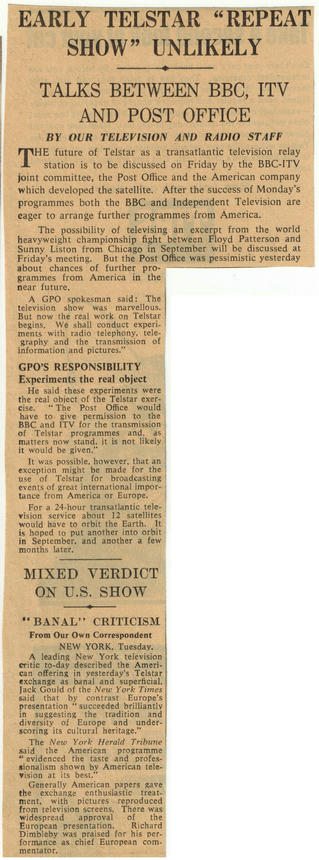Scrapbook 3: Early Telstar "Repeat Show" Unlikely

EARLY TELSTAR “REPEAT SHOW” UNLIKELY
TALKS BETWEEN BBC, ITV AND POST OFFICE
BY OUR TELEVISION AND RADIO STAFF
THE future of Telstar as a transatlantic television relay station is to be discussed on Friday by the BBC-ITV joint committee, the Post Office and the American company which developed the satellite. After the success of Monday’s programmes both the BBC and Independent Television are eager to arrange further programmes from America.
The possibility of televising an excerpt from the world heavyweight championship fight between Floyd Patterson and Sunny Liston from Chicago in September will be discussed at Friday’s meeting. But the Post Office was pessimistic yesterday about chances of further programmes from America in the near future.
A GPO spokesman said: The television show was marvellous. But now the real work on Telstar begins. We shall conduct experiments with radio telephony, telegraphy and the transmission of information and pictures.“
GPO’S RESPONSIBILITY
Experiments the real object
He said these experiments were the real object of the Telstar exercise. “The Post Office would have to give permission to the BBC and ITV for the transmission of Telstar programmes and, as matters now stand, it is not likely it would be given.”
It was possible, however, that an exception might be made for the use of Telstar for broadcasting events of great international importance from America or Europe.
For a 24-hour transatlantic television service about 12 satellites would have to orbit the Earth. It is hoped to put another into orbit in September, and another a few months later.
MIXED VERDICT ON U.S. SHOW
“BANAL” CRITICISM
From Our Own Correspondent NEW YORK, Tuesday.
A leading New York television critic to-day described the American offering in yesterday’s Telstar exchange as banal and superficial. Jack Gould of the New York Times said that by contrast Europe’s presentation “succeeded brilliantly in suggesting the tradition and diversity of Europe and underscoring its cultural heritage.”
The New York Herald Tribune said the American programme “evidenced the taste and professionalism shown by American television at its best.”
Generally American papers gave the exchange enthusiastic treatment, with pictures reproduced from television screens. There was widespread approval of the European presentation. Richard Dimbleby was praised for his performance as chief European commentator.